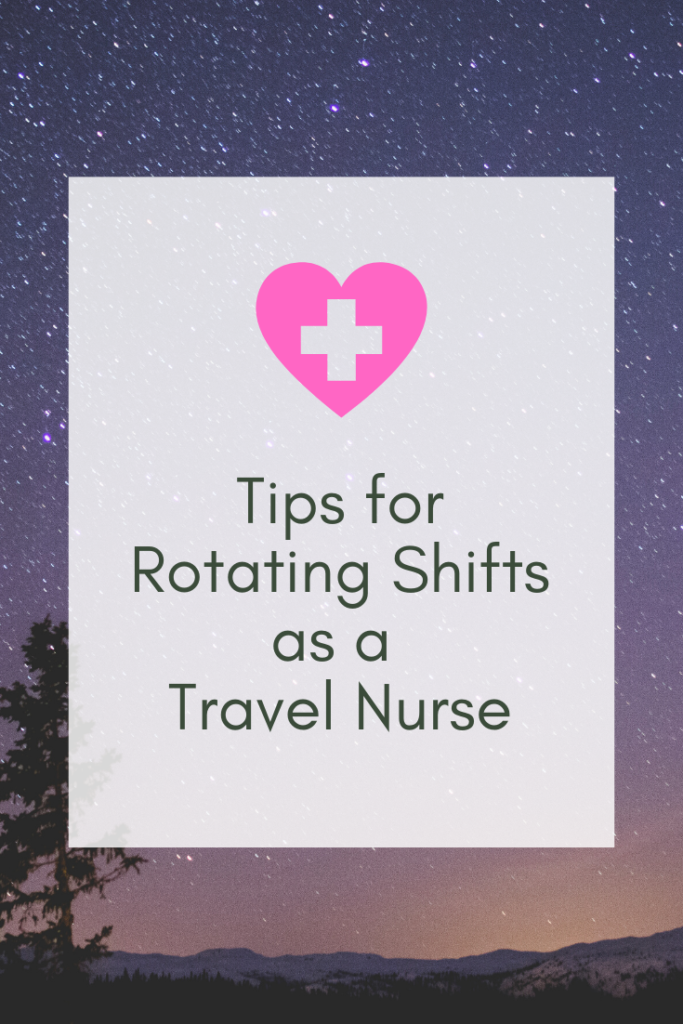Tips for Rotating Shifts as a Travel Nurse
Are you awake enough to hear my tips for rotating shifts as a Travel Nurse? Or did you just work all night, take a 3 hour nap, and are barely functioning? I’ll try to keep this short and sweet to help you survive night shift and a constant change between night shift and day shift.
Travel Nursing is an incredible way to explore more, develop awesome nursing skills, meet new people, find yourself, make some extra money, and more.
It also comes with the requirement of being flexible.
Some Travel Nurse contracts might be day shift, some might be night shift, and some might be rotating between the two. I’ve done it all, and it can be rough.
I did Travel Nursing for 3 years, and I’m here to share my best tips for rotating shifts as a Travel Nurse. The better you sleep, the more likely you’ll be up for an adventure – which is the whole point of Travel Nursing 🙂
What is Travel Nursing?
Travel Nursing is working as a Nurse in different places for short periods of time. You are hired by a Travel Nurse Agency, and you typically work 8-13 week contracts at different hospitals or clinics that are in need of short-term help. If you are brand new to this concept, read my Advice for Travel Nurses first, and explore the Best Reasons to become a Travel RN and the Cons of Travel Nursing. It is an awesome career path, but you should know what you’re getting into.
Why you might have to work night shift or rotating shifts
Travel Nurses get jobs where there is a huge need for nurses. While some people love night shift, a lot of people don’t. This means that there are often more openings for night shift – it’s where the need is. Also, some hospitals require all nurses to rotate, typically doing 2 weeks of night shift then 2 weeks of day shift and so forth.
If you have your heart set on a certain location or need to find a job quickly, you might have to take what is open. That might equal night shift or rotating shifts.
Tips for Rotating Shifts as a Travel Nurse
Try to do block scheduling
Most schedulers who schedule night shifters try to do block scheduling, working 3 in a row. Request this if it’s not automatically done. If you work a block schedule, it is easier to swap back and forth between night shift life and regular life.
Learn what works for you
People are different. Try out different ways to cope with night shift, and stick to what works for you.
Some night shifters like to stay on a night shift schedule. They sleep all day and stay awake all night whether they are working or not. They are the lone people grocery shopping in Target at 3am. These nurses consistently get 7-9 hours of sleep, but it’s always between the hours of 7am and 5pm.
Some night shifters like to get back to a normal schedule when they have consecutive days off. Here’s an example of what I used to do: Work Monday-Wednesday night. I would sleep normal hours on Sunday night, wake up somewhat early on Monday, then take a nap from 1pm-5pm before my first shift. I would sleep all day between shifts. Then I would get off work on Thursday morning, take a 4 hour nap, wake up around noon, and desperately try to stay awake until a normal bedtime. I was available to hang out with people and function during normal hours, but I was also often sleep deprived.
Try out different tips on this list and figure out what makes you feel the best.
Make your room dark
By dark I mean nighttime dark. Get black out curtains or put a piece of cardboard in front of your window. Block the window light during the day when you’re trying to sleep, and remove the cardboard or black out curtains when you’re on a normal schedule.
My friend cut a large piece of cardboard to fit in her window. It almost fully blocked the light and was much cheaper/easier than black out curtains.
Have white noise options
The majority of the population functions during the day, and most people don’t think about how what they do might affect sleeping nurses. Your neighbors might mow the lawn, have people over for brunch, or play music. You need to have a way to block out that noise. White noise is especially important if you live in an apartment complex or have roommates.
Options: You can download a white noise app on your phone. My favorite is Relax Melodies and the Heavy Rain sound. They sell white noise machines that will be louder than an app on your phone. If they won’t bother your sleep, you can try noise cancelling headphones. Or the tried and true loud fan can be your best option.
Learn to love naps
Remember when we were kids and we would rather throw an actual fit than take a nap?
Not now. Napping needs to be one of your new favorite things to do. Night shift and rotating shifts often means not getting enough sleep. Sometimes naps are necessary, and they are proven to be good for you. Don’t look at it like you’re wasting your day. Look at it like you are improving your health and mental well-being.
Try a sleep app on your phone
You can do almost anything on your phone now, including listening to bedtime meditations or sounds that can help you fall asleep. The Relax Melodies app that I mentioned above has different sleep meditations on it. Or here’s a list of the 10 best sleep apps.
Consider taking medication to help you sleep
If your body and brain are saying “absolutely not” to sleep, you might want to try a sleep aid. They can help you fall asleep and help you stay asleep, but some can leave you feeling drowsy. Talk to your doctor to make sure you don’t take anything that will interfere with medications that you already take. Never take sleep medications with alcohol.
Here are a few over the counter options:
Diphenhydramine/Benadryl. This is a sedating antihistamine. You can buy 25mg tablets and break them in half to start with small doses.
Melatonin. This is a hormone that helps you control your natural sleep-wake cycle. It’s more natural than benadryl but might not work as well. It can interact with birth control, so be aware of that.
Doxylamine Succinate/Unisom. Also a sedating antihistamine.
I struggled with being able to fall asleep and then would get anxiety thinking that I would get zero sleep before a 12 hour shift. What worked for me: I would take 12.5mg of Diphenhydramine before going to sleep in the morning, and if I woke up at noon tossing and turning, I would take another 12.5mg. I typically avoid taking medications if possible, but if it was between no sleep and 25mg of benadryl, I chose to take the benadryl. Obviously, this is totally up to you.
Know that sometimes you will not be able to sleep
Have you ever heard of circadian rhythm? A circadian rhythm is a natural, internal process that regulates the sleep-wake cycle and repeats on each rotation of the Earth, roughly every 24 hours.
A circadian rhythm is almost always malfunctioning while on night shift or when rotating between days and nights.
Your body and brain will get so confused when one day you sleep from 8am-5pm and 2 days later you try to sleep from 10pm-7am.
You can be exhausted, but sometimes you will not be able to fall asleep. You might try every tip on this list and nothing works. Deep breaths; it will be okay. Try not to get frustrated, and know that you will eventually get sleep again. You will learn what this feels like, and you might know that sleep isn’t in the cards for you anytime soon. Get up, do something else, then try again in an hour.
I hope some of these tips help! If you have any advice that could help others, leave it in a comment below. Travel Nursing gives you the opportunity to see the world; I hope this post helps you to be awake for it.

Pin this for later!







Comments? Ideas? Advice? Leave some!